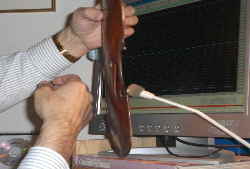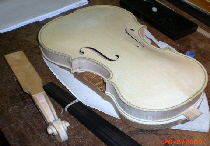|
Use a shortened table knife to remove the front plate (the belly) and the fingerboard, but do be careful. You are trying to ease the knife into the joint and ‘lever' the plate off, not to cut into the joint.
Removing the front (belly) is made much easier if you carefully feed into the joint a little warm Isopropyl alcohol mixed with water (50/50). I have used it heated in a baby bottle warmer to 50 degC, and the belly came off in about 10 minutes with very little damage, but it can take a day. Note that the alcohol may well damage or soften some varnishes, so experiment first, and be prepared to touch up the varnish carefully later.
When all the belly is nearly off, feed a small amount of the warm alcohol/water fluid down or via a long bladed knife to get it into the top block joint with the belly held slightly open. And with that the belly should come off relatively undamaged.
Dangers
I've managed to cut myself quite badly doing this on my left hand, as I'm right handed. Always cut away from your left hand, as the knife can suddenly fly out of control as the joint gives way, so using a leather gardening glove on your left hand reduces the risk of a serious wound a lot!
*: Footnote on accuracy: As this method measures Mode 5 indirectly then there is a possible inaccuracy. I estimate that using this method there is a Standard Deviation of ~4.1%. That means that my estimates are 68% likely to be in error by not more than 4.1 %, and 95.5% likely to be out by no more than 8.2%. There's more detail on this here on the Wikip'dia page.
** This is by using the thumb plane(s) on the inside of back and front plates, leaving the varnish intact. Obviously you cannot alter the arching at all with this method unless the back is over-thick and you are prepared to refinish the back.
|


